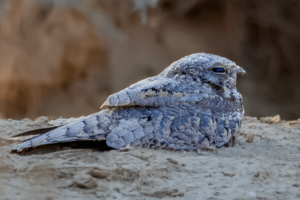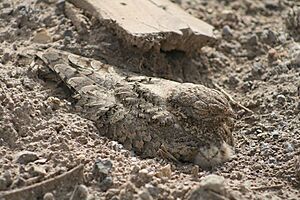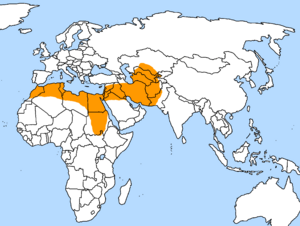Egyptian nightjar facts for kids
Quick facts for kids Egyptian nightjar |
|
|---|---|
 |
|
| Conservation status | |
| Scientific classification | |
| Genus: |
Caprimulgus
|
| Species: |
aegyptius
|
The Egyptian nightjar (Caprimulgus aegyptius) is a medium-sized bird. It lives in parts of Asia and North Africa. In winter, it flies to warmer tropical Africa. This bird is quite common. It lives in many places. Scientists say it is of "least concern" for now. This means it's not in danger of disappearing. But losing its home is a problem.
What's in a Name?
The name Caprimulgus comes from Latin words. Capra means "nanny goat" and mulgere means "to milk". This is because of an old story. People used to believe nightjars drank milk from goats! The second part of its scientific name, aegyptius, means "Egyptian".
The common name "nightjar" was first used in 1630. "Night" tells us it is active at night. "Jar" comes from the special sound it makes. It sounds like a churring noise.
What Does It Look Like?
The Egyptian nightjar has feathers that are much lighter than other nightjars. Its colors help it blend in. It is sandy-colored with streaks of buff and brown. Its belly is sandy or whitish.
This bird is smaller than some other nightjars. But it has longer wings and a longer tail. Like all nightjars, it has a very wide mouth. This helps it catch insects. It also has long wings and soft, fluffy feathers.
Male Egyptian nightjars have tiny white spots on their wings. This bird is about 25 centimeters (10 inches) long. Its wings can spread up to 55 centimeters (22 inches) wide. Its call is a repeated "kroo-kroo-kroo..." sound. The sound gets louder and softer as the bird turns its head.
Where Does It Live?
The Egyptian nightjar lives in North Africa, the Arabian Peninsula, and the Middle East. You can find it in many countries. These include Egypt, Saudi Arabia, Iran, and Pakistan. It also lives in parts of Central Asia.
Sometimes, it visits Europe. It has been seen in places like Germany and the United Kingdom. Its favorite home is open desert areas. It likes places with a few scattered trees or bushes. You might also find it near water. It prefers areas with thin plants and scrub. In winter, birds in Sudan like areas with tall grass.
How Does It Live?
During the day, this nightjar rests quietly on the ground. Its colors help it hide perfectly in the sand. It is very hard to spot!
It starts flying at dusk, usually when the sun sets. It flies quietly, like a moth. Its strong wings beat, then it glides with its wings still. The Egyptian nightjar eats insects that are active at dusk. Moths are a favorite food.
This bird does not build a nest. It lays two long, oval-shaped eggs right on the bare ground. The parent bird sits very close to the eggs. This helps keep them safe. In North Africa, they breed in deserts and sandy areas. These places often have limestone rocks. In winter, they live in dry areas with special plants.




